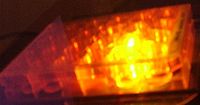
Resazurin
Encyclopedia

Viability assay
A viability assay is an assay to determine the ability of cells or tissues to maintain or recover its viability. For example, examining the ratio of potassium to sodium in cells indicates viability because if cells do not have high intracellular potassium and low intracellular sodium: the...
s for bacteria and mammalian cells. Usually it is available commercially as the sodium salt.
Resazurin solution has one of the highest values known of Kreft's dichromaticity index. This means that it has a large change in perceived color hue
Hue
Hue is one of the main properties of a color, defined technically , as "the degree to which a stimulus can be describedas similar to or different from stimuli that are described as red, green, blue, and yellow,"...
when the thickness or concentration of observed sample increases or decreases.


Cell Viability applications
Resazurin was first used to quantify bacterial content in milk by Pesch and Simmert in 1929.It is also used as an indicator for cell viability in mammalian cell cultures.
It was introduced commercially initially under Alamar Blue trademark (Trek Diagnostic Systems, Inc), and now also available under other names such as AB assay, Vybrant (Molecular Probes
Molecular Probes
Molecular Probes is a biotechnology company located in Eugene, Oregon specializing in fluorescence. The company was founded in 1975 by Richard and Rosaria Haugland in their kitchen in Minnesota, then moved briefly to Texas and finally to Oregon in the early 1980s. In 1989, Molecular Probes moved...
) and UptiBlue (Interchim
Interchim
Interchim is a privately owned French company specialized in manufacturing and distribution of reagents, consumables and dedicated instruments for the R&D and industry laboratory in the fields of fine chemistry, chromatography and bio-analysis....
).
Resazurin based assays show excellent correlation to reference viability assays such as formazan
Formazan
Formazan dyes are artificial chromogenic products of the reduction of tetrazolium salts by dehydrogenases and reductases. They have a variety of colors from dark blue to deep red to orange, depending on the original tetrazolium salt used as the substrate for the reaction.Leading examples of...
-based assays (MTT
MTT assay
The MTT assay and the MTS assay are colorimetric assays for measuring the activity of enzymes that reduce MTT or close dyes to formazan dyes, giving a purple color. A main application allows to assess the viability and the proliferation of cells...
/XTT) and tritiated thymidine based techniques, while being much easier and safer to use for the user. It also allows for longer studies (minimally toxic to living cells), works for adherents cells and bacteria/fungi. Besides standard applications as cell culture assays
Cell culture assays
In Biomaterials Testing, a cell culture assay is any method which is used to assess the cytotoxicity of a material. This refers to the in vitro assessment of material to determine whether it releases toxic chemicals in sufficient quantities to kill cells either directly or indirectly through the...
(cell counting, cell proliferation assays) and cytotoxicity testing, it also can be multiplexed with several chemiluminescent assays, such as cytokine assays, caspase assays to measure apoptosis, or reporter assays to measure a gene or a protein expression.
Other applications
Resazurin is effectively reduced in mitochondria, making it useful also to assess mitochondrial metabolicMetabolism
Metabolism is the set of chemical reactions that happen in the cells of living organisms to sustain life. These processes allow organisms to grow and reproduce, maintain their structures, and respond to their environments. Metabolism is usually divided into two categories...
activity.
Usually, in the presence of diaphorase as the enzyme, NADPH or NADH is the reductant that converts resazurin to resorufin. Hence the resazurin/diaphorase/NADPH system can be used to detect NADH, NADPH, or diaphorase level, and any biochemical or enzyme activity that is involved in a biochemical reaction generating NADH or NADPH.
Resazurin can be used to assay L-Glutamate
Glutamic acid
Glutamic acid is one of the 20 proteinogenic amino acids, and its codons are GAA and GAG. It is a non-essential amino acid. The carboxylate anions and salts of glutamic acid are known as glutamates...
, achieving a sensitivity of 2.0 pmol per well.
Close dyes
10-acetyl-3,7-dihydroxyphenoxazine (also known as Amplex Red), structurally related to resazurin, reacts with H2O2 in a 1:1 stoichiometry to produce the same by-product resorufin (used in many assays combining for example horseradish peroxidaseHorseradish peroxidase
The enzyme horseradish peroxidase , found in horseradish, is used extensively in biochemistry applications primarily for its ability to amplify a weak signal and increase detectability of a target molecule.-Applications:...
(HRP), or NADH, NADPH using enzymes).
7-ethoxyresorufin, is a compound used as the substrate in the measurement of cytochrome P450 (CYP1A1
CYP1A1
Cytochrome P450, family 1, subfamily A, polypeptide 1 is a protein that in humans is encoded by the CYP1A1 gene. The protein is a member of the cytochrome P450 superfamily of enzymes.-Function:...
) induction using the ethoxyresorufin-O-deethylase (EROD) assay system in cell culture and environmental samples, produced in response to exposure to aryl hydrocarbons. The compound is catalysed by the enzyme to produce the same fluorescent product, resorufin.

